#Acclimatization on Kilimanjaro
Explore tagged Tumblr posts
Text
Mount Kilimanjaro Acclimatization - Tips for a Successful Summit
Mount Kilimanjaro Climbing is a dream adventure for many, but reaching the summit requires proper acclimatization. The climbing of Mount Kilimanjaro takes you through diverse climatic zones, from lush rainforests to icy glaciers. A slow and steady ascent is essential to avoid altitude sickness and ensure the Best Kilimanjaro Climbing Experience.
youtube
Choosing a longer route, such as the Lemosho or Machame, allows better acclimatization. Hydration, proper nutrition, and rest days play a crucial role in adapting to higher elevations. Monitoring symptoms like headaches or dizziness and following the "climb high, sleep low" strategy significantly improves your chances of success.
For a safe and rewarding Kilimanjaro Climbing Experience, trekking with experienced guides is essential. African Scenic Safaris offers expert-led climbs with carefully planned itineraries, ensuring optimal acclimatization and an unforgettable journey to the Roof of Africa!
#mount kilimanjaro climbing#acclimatization of mount kilimanjaro#best kilimanjaro climbing experience
0 notes
Link
The biggest hurdle to overcome when climbing Kilimanjaro is acclimatization. Here are several ways to prevent altitude sickness.
0 notes
Text
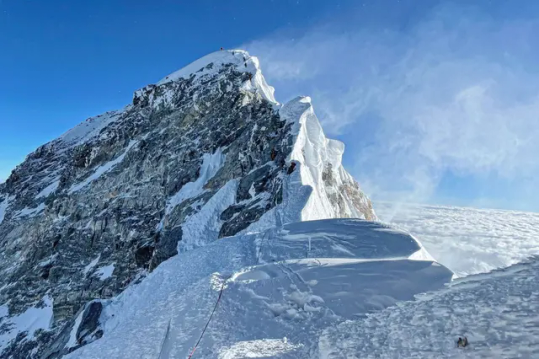

Why are Hundreds of Climbers Heading into the ‘Death Zone’ on Mt Everest This Spring?
Thick murky clouds fill the sky, with freezing winds carrying snow faster than 100 miles per hour. With a frigid –30 degrees Fahrenheit temperature, life-threatening snowstorms and avalanches are frequent.
And these are typical conditions on the world’s highest mountain: Mount Everest.
The behemoth towers 29,032 feet (8,849 meters) between Nepal and Tibet in the Himalayas, with its peak surpassing most clouds in the sky.
An attempt to climb Everest requires months, sometimes years, of training and conditioning – even then, reaching the summit is far from guaranteed. In fact, more than 300 people are known to have died on the mountain.
And yet the mountain still draws hundreds of climbers who are determined to reach its peak every spring. Here’s what it takes to make the climb and what has motivated some climbers to summit the world’s highest peak.
‘I thought I was in pretty good shape’
Dr. Jacob Weasel, a trauma surgeon, successfully summited Everest last May after conditioning for nearly a year.
“I would put on a 50-pound backpack and do two hours on a stair stepper with no problem,” Weasel said. “So, I thought that I was in pretty good shape.” However, the surgeon said he was humbled after discovering that his fitness was no match for the lofty athleticism required by the mountain.
“I would take five steps and have to take 30 seconds to a minute to catch my breath,” Weasel recalled of his struggle with the lack of oxygen available while ascending Everest.
Climbers aiming for the summit usually practice an acclimatizing rotation to adjust their lungs to the thinning oxygen levels once they arrive on the mountain. This process involves mountaineers traveling upward to one of the four designated camps on Everest and spending one to four days there before traveling back down.
This routine is repeated at least two times to allow the body to adapt to declining oxygen levels. It increases a climber’s chances of survival and summiting.
“If you took somebody and just plopped them up at the high camp on Everest, not even on the (top), they would probably go into a coma within 10 to 15 minutes,” Weasel said.
“And they would be dead within an hour because their body is not adjusted to that low of oxygen levels.”
While Weasel has successfully summited dozens of mountains, including Kilimanjaro (19,341 ft), Chimborazo (20, 549 ft), Cotopaxi (19,347 ft), and most recently Aconcagua (22,837 ft) in January, he said none of them compares to the high-altitude of Mount Everest.
“Because no matter how well you are trained, once you get to the limits of what the human body can take, it’s just difficult,” he continued.
At its highest altitude, Everest is nearly incapable of sustaining human life and most mountaineers use supplementary oxygen above 23,000 feet. The lack of oxygen poses one of greatest threats to climbers who attempt to summit, with levels dropping to less than 40% when they reach the Everest “death zone.”
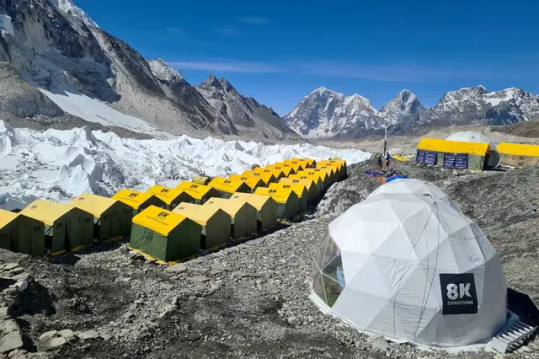
Tents of mountaineers are pictured at Everest base camp in the Mount Everest region of Solukhumbu district on April 18, 2024.
‘It’s difficult to survive up there’
The first target for mountaineers is Everest base camp at approximately 17,000 feet, which takes climbers about two weeks. Then they ascend to the three remaining camps stationed along the mountain.
Camp four, the final one before the summit, sits along the edge of the death zone at 26,000 feet, exposing climbers to an extremely thin layer of air, subzero temperatures, and high winds powerful enough to blow a person off the mountain.
“It’s difficult to survive up there,” Weasel said. He recalls passing bodies of climbers who died on the mountain – which isn’t uncommon. The bodies of the fallen mountaineers are well-preserved, exhibiting little to no decay due to the intense cold temperatures.
“I am probably more familiar with death and the loss of life than most people,” the surgeon said. “For me it was just a reminder of the gravity of the situation and the fragility of what life is… even more so motivation for appreciating the opportunity.”
High-altitude cerebral edema (HACE) is one of the most common illnesses climbers face while attempting to summit. “Your brain is starved of oxygen,” Weasel said.
HACE results in the brain swelling during its attempt to regain stable oxygen levels, causing drowsiness, trouble speaking and thinking. This confusion is often accompanied by blurred vision and sporadic episodes of delusion.
“I had auditory hallucinations where I was hearing voices [of friends] that I thought were coming from behind me,” Weasel recalled. “And I had visual hallucinations,” he added. “I was seeing the faces of my children and my wife coming out of the rocks.”
Weasel recalled crossing paths with a friend, Orianne Aymard, who was trapped on the mountain due to an injury. “I remember staring at her for like five minutes and just saying, ‘I’m so sorry,’” Weasel said.
“I’ve spent over a decade of my life training to help people as a surgeon, and being in a position where there’s somebody who requires your help and you are unable to offer any assistance… that feeling of helplessness was tough to deal with,” Weasel said.
Aymard survived. She was rescued and suffered from several broken bones in her foot, in addition to severe frostbite on her hands. Despite all her injuries, Aymard is considered one of the lucky ones.
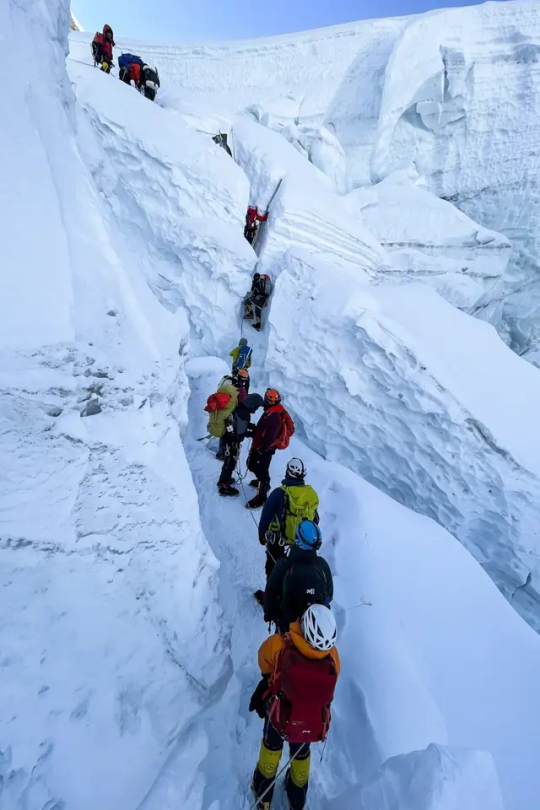
Mountaineers climbing during their ascend to summit Mount Everest on May 7, 2021.
‘Their bodies will get frozen into the mountain’
Everest has long been a tomb for climbers who have succumbed to harsh conditions or accidents on its slopes.
When a loved one or fellow climber is severely injured or dies on the mountain, it’s routine to leave them behind if you’re unable to save them, according to Alan Arnette, a mountaineer coach who summited Everest in 2014.
“What most teams do out of respect for that climber, they will move the body out of sight,” he said. And that’s only if they can.
“Sometimes that’s just not practical because of the bad weather, or because their bodies will get frozen into the mountain,” Arnette said. “So, it’s very difficult to move them.”
Seeing a corpse on Everest is comparable to seeing a horrible car accident, according to the mountain coach. “You don’t turn around and go home,” Arnette said. “You respectfully slow down… or say a prayer for that person, and then you continue.”
It’s been 10 years since the single deadliest accident on the world’s highest mountain, after an avalanche killed 12 Sherpa guides. And 2023 was recorded as the deadliest year on Everest, with 18 fatalities on the mountain – including five people that are still unaccounted for.
The process of recovering bodies is extensive, sometimes impossible. Helicopter rescues and search missions are challenging due to the high altitude and frequently treacherous conditions, resulting in some rescuers dying in their attempt to save others.
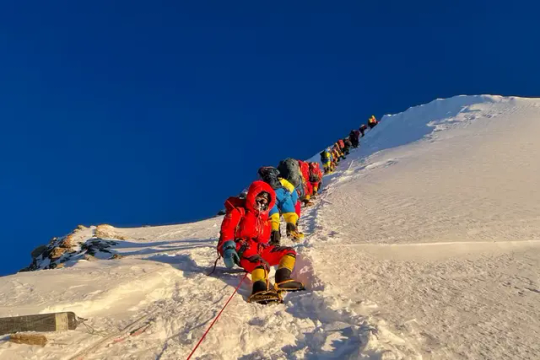
Mountaineers as they climb during their ascend to summit Mount Everest on May 12, 2021.
‘Watching the sunrise from 29,000 feet’
The 3,000 feet climb from camp four to the summit can take anywhere from 14 to 18 hours. Therefore, mountaineers typically leave the camp at night.
“That entire night was cold,” Weasel recalled. “It’s dark, it’s windy.” But it was proven to be worth it in the morning, he said.
“Watching the sunrise from 29,000 feet and having that pyramid of Everest’s shadow projected onto the valley below you…,” Weasel said. “It was probably one of the most beautiful things I’ve ever seen in my life,” he continued.
“It’s weird standing up there and knowing that everything else on the planet is below where you’re standing.”
The size of the mountain is humbling, the surgeon said. “I’ve never felt so small,” he recalled. “That mixture of humility and connectedness with something bigger than yourself is the proper place from which we ought to approach our existence on this planet.”
Like Weasel, Arnette summited at sunrise, and experienced this same feeling of “smallness.” At the top there were “more mountains than you can count,” Arnette remembered. “It was a sense of enormous gratitude and at the same time I knew I had to get back down.”
After about 20 minutes to an hour, climbers typically start to descend back to the base of the mountain.
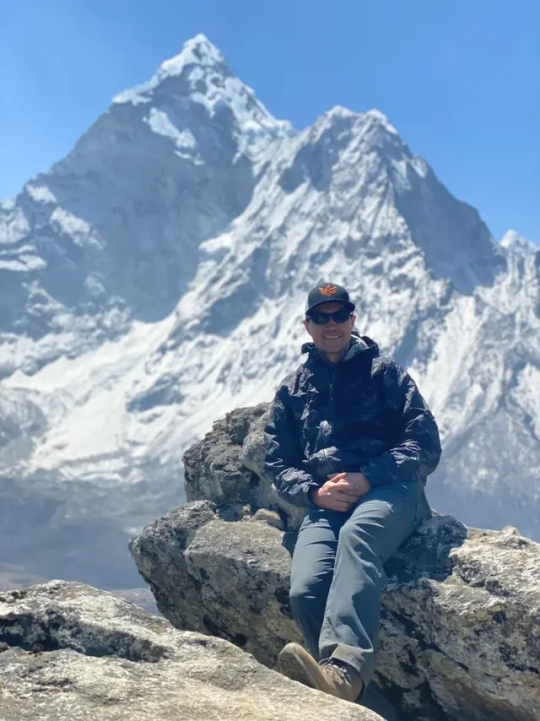
Jacob Weasel.
‘Bigger than yourself’
Before leaving for Nepal, Weasel was gifted an eagle’s feather as a beacon for his Native American heritage.
He was determined to plant the feather on top of Everest “as a symbol of our people and what we’ve endured for the past several hundred years,” Weasel said. “Showing that our spirit is not broken, but we’re able to rise above the things that have happened to us,” he added.
“I remember planting that eagle’s feather on the top of the world and the feeling of real privilege that I felt in representing our people.” And this is why he decided to summit Everest, to be an example that anything is possible for young Native children and his tribe.
“Knowing what it’s like up there, for me personally, the only real justification for going and putting your life, and other lives, at risk is if you’re climbing for a reason that is much bigger than you,” said Weasel.
Arnette attempted to climb Everest three times before he successfully summited.
“My first three tries, I wasn’t clear on my why,” Arnette said. When his mother was diagnosed with Alzheimer’s disease, he looked at his purpose for climbing differently.
“I wanted to do it to raise money for Alzheimer’s and honor my mother,” Arnette said.
There are approximately 300 people that have been issued a permit from the Nepal government to climb the mountain this year, according to Arnette. And he said the number is down from previous years.
“I think one of the reasons is because we had the 18 deaths last year, and people realize that Mount Everest is a dangerous mountain.”
However, he doesn’t believe that should deter climbers from attempting to summit. “I’m a big believer that when you go climb these mountains that you come home a better version of yourself,” Arnette said.
“Everest has become too commercialized with ‘you’re stepping over dead bodies’ and ‘it’s littered with trash,’” the mountain coach said. “The reality is that it is a very small degree all of that, but there’s a lot of joy that people get out of doing it,” he continued.
“And that’s the reason that we climb mountains.”
By Kara Nelson.
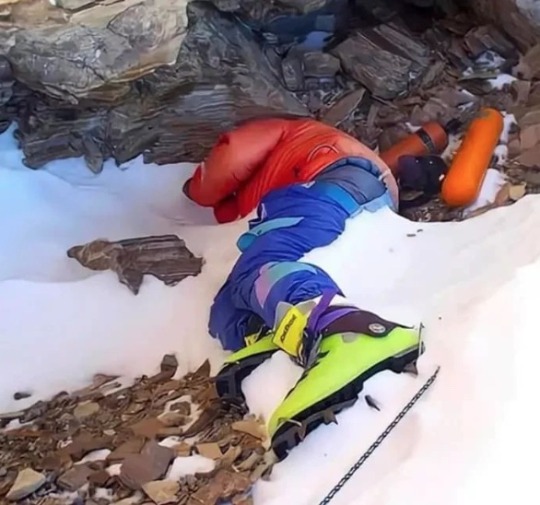

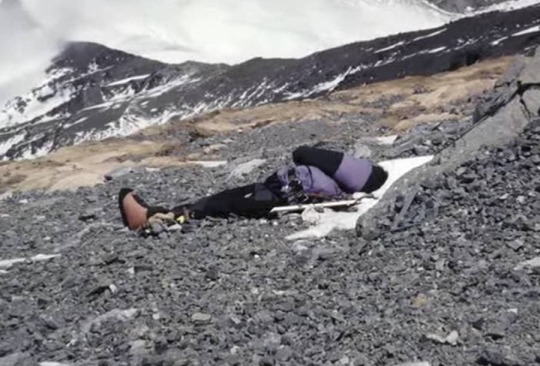
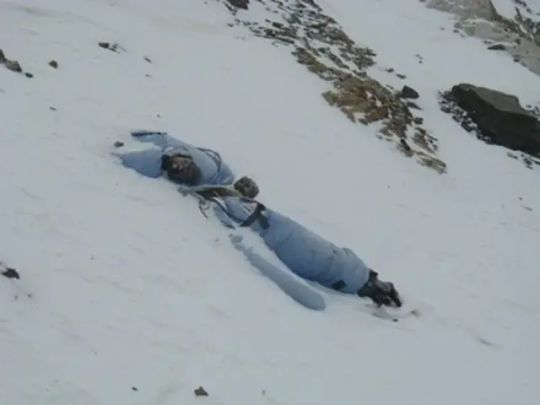
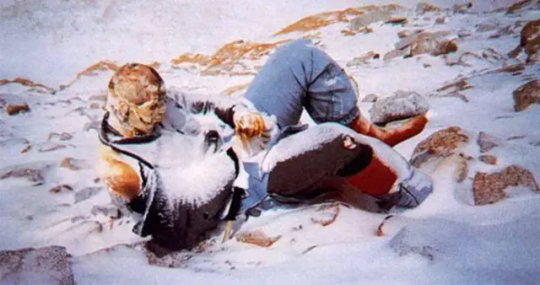
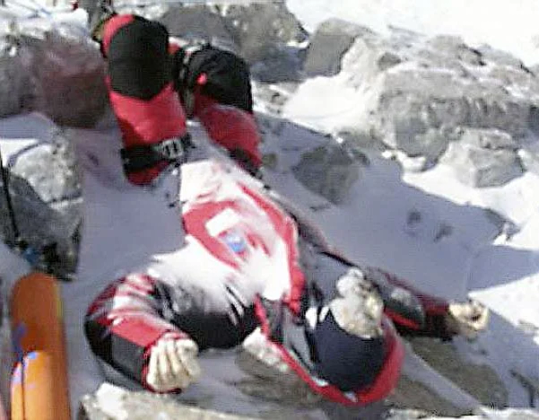
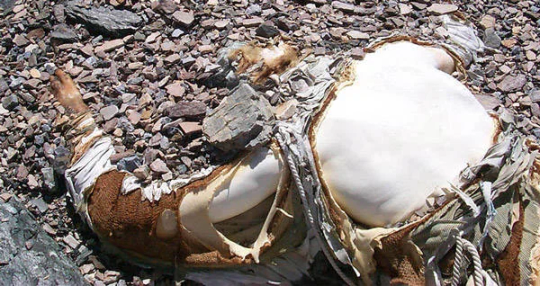
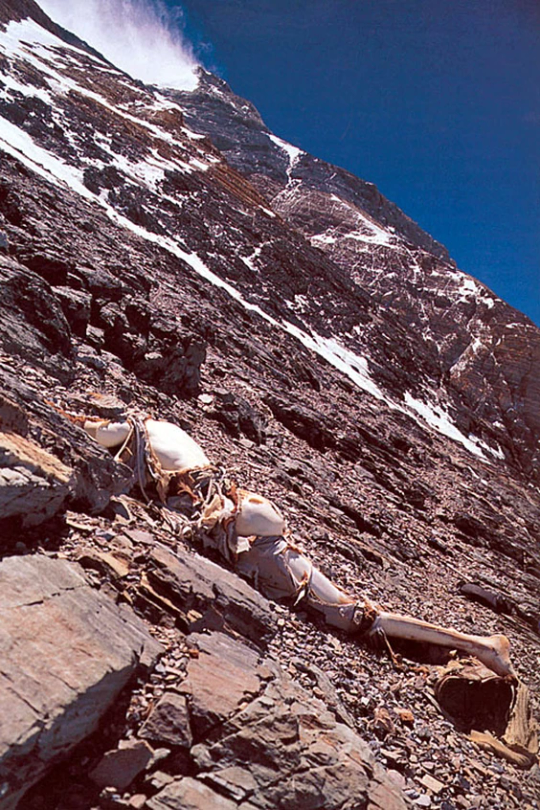
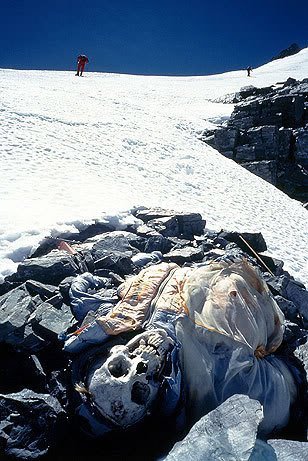
#Mt Everest#Mount Everest#Everest#The Death Zone#Why are Hundreds of Climbers Heading into the ‘Death Zone’ on Mt Everest This Spring?#world’s highest mountain#the Himalayas#mountain climbing#death on a mountain#history#history news#long reads#long post#long story
40 notes
·
View notes
Text
31 March 2025,
After today’s course on wilderness first aid, I’ve gained a deeper respect for nature, my body, and the resources that I can rely on. Excited to build on my acclimatization experience and embrace what’s ahead. Kilimanjaro and Manaslu, see you soon! 🏔
Knowing myself, I’ll probably still be trekking solo as usual — unless someone like myself comes along, which is highly unlikely. Regardless, I’m all set for my own adventure.
5 notes
·
View notes
Text

Best Time to Climb Kilimanjaro for Beginners: A Seasonal Guide
Conquering the majestic Mount Kilimanjaro is a dream for many, but for beginners, choosing the right time to climb is crucial. In this blog post, we'll explore the best seasons to climb Kilimanjaro for those new to the mountain, considering factors such as weather, crowds, and overall conditions.
Peak Season (December to February, June to August)
Pros:
Pleasant weather: Clear skies, minimal rainfall, and comfortable temperatures make it ideal for beginners.
Abundant wildlife: Spot a variety of animals, including the elusive mountain zebra.
Well-maintained trails: Enjoy well-defined paths and increased availability of services.
Cons:
Crowds: Be prepared for larger groups of climbers and potentially longer wait times.
Higher prices: Accommodation and other services may be more expensive during peak season.
Shoulder Season (March to May, September to November)
Pros:
Fewer crowds: Enjoy a more peaceful and intimate experience.
Lower prices: Save money on accommodation and other expenses.
Pleasant weather: Still enjoy comfortable conditions with fewer crowds.
Cons:
Potential for rain: Be prepared for occasional showers or mist.
Reduced availability of services: Some accommodations and amenities may be less accessible.
Off-Peak Season (January, February, March, April, May, October, November, December)
Pros:
Significantly lower prices: Enjoy significant savings on your trip.
Fewer crowds: Experience a truly solitary climb.
Cons:
Potentially harsher weather: Be prepared for colder temperatures and more rainfall.
Reduced availability of services: Limited accommodations and amenities may be available.
Factors to Consider When Choosing a Season for Beginners
Weather: If you're a beginner, it's recommended to choose a season with pleasant weather to minimize challenges. The peak and shoulder seasons offer the most favorable conditions.
Crowds: If you prefer a less crowded experience, consider the shoulder or off-peak seasons.
Budget: The off-peak season is the most budget-friendly option, but you might encounter harsher weather conditions.
Physical fitness: If you're not in peak physical condition, the shoulder or off-peak seasons may allow for more gradual acclimatization.
Highlight: PoaPoa Tours' Beginner-Friendly Kilimanjaro Packages
At PoaPoa Tours, we offer tailored Kilimanjaro trekking packages for beginners, considering the best time of year to climb based on your preferences and experience level. Our packages include:
Peak Season: Enjoy optimal weather conditions and abundant wildlife sightings.
Shoulder Season: Experience fewer crowds and potentially lower prices.
Off-Peak Season: Benefit from lower costs and more intimate trekking experiences
#KilimanjaroClimb#BeginnerTrekking#KilimanjaroTrekking#AdventureAwaits#PoaPoaTours#MountainClimbing#ExploreTanzania#Kilimanjaro#TravelTips#HikingAdventures#OutdoorExploration#NatureLovers#ClimbingSeasons#TravelSmart#WildlifeAdventure#TanzaniaSafari#BucketList#AdventureTravel#TrekkingPackages#HikingKilimanjaro#BeginnerClimbers
2 notes
·
View notes
Text
15 Toughest Treks in the World for Hiking Enthusiasts
Are you an adventurer at heart, always seeking the next thrilling journey? If the whisper of the wind through the pines, the allure of the untamed wilderness, and the exhilaration of ascending to new heights stir your soul, then this is the blog for you.
Welcome to our curated list of the 15 toughest treks in the world. These aren’t your average hikes; they’re thrilling adventures that push you to your limits, challenge your resilience, and reward you with breathtaking views and unforgettable experiences.
From the harsh arctic landscapes of Greenland to the towering peaks of the Nepalese Himalayas, each of these treks offers a unique journey that will test your endurance and ignite your adventurous spirit.
So, lace up your boots, pack your gear, and join us as we explore the thrilling world of extreme trekking. The mountains are calling – are you ready to answer?
Table Of Contents
1. Everest Base Camp Trek, Nepal 2. The Snowman Trek, Bhutan 3. The Pacific Crest Trail, USA 4. The Mount Kilimanjaro Trek, Tanzania 5. The Inca Trail to Machu Picchu, Peru 6. Mount Elbrus Trek, Russia 7. The Great Himalaya Trail, Nepal 8. Appalachian Trail, USA 9. Overland Track, Australia 10. GR20, Corsica 11. The Polar Route, Greenland 12. Routeburn Track, New Zealand 13. Larapinta Trail, Australia 14. The Long Range Traverse, Canada 15. Dientes Circuit, Chile Conclusion
1. Everest Base Camp Trek, Nepal
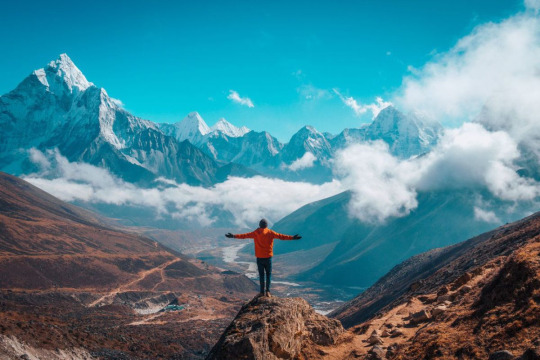
Embark on a journey to the foot of the highest peak in the world. The Everest Base Camp trek is not just a trek but a journey through the heart of the majestic Himalayas. This trek takes you through diverse landscapes, from lush valleys, glacial moraines, and terraced fields to pine forests and Sherpa villages. Along the way, you’ll encounter suspension bridges, ancient monasteries, and, of course, breathtaking views of some of the world’s tallest mountains. It’s a true test of endurance and acclimatization, but the reward is a firsthand view of Everest’s grandeur.
Altitude: 5,545 meters (18,192 ft)
Best Time to Go: March to May and September to November
Difficulty Level: Challenging
2. The Snowman Trek, Bhutan
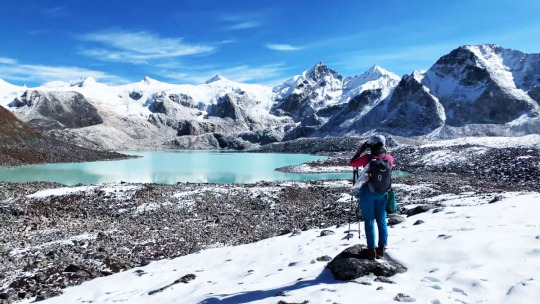
Touted as one of the most difficult treks in the world, the Snowman Trek traverses through eleven high-altitude passes, each over 4,500 meters. The journey unfolds across the remote Lunana region, offering a deep dive into Bhutan’s rich cultural heritage and lush, untouched landscapes. Expect to encounter serene mountain lakes, majestic peaks, isolated villages, and diverse wildlife. This trek is as mentally demanding as it is physically due to its length and the isolation of the terrain.
Altitude: 5,320 meters (17,454 ft)
Best Time to Go: September to October
Difficulty Level: Very Challenging
3. The Pacific Crest Trail, USA
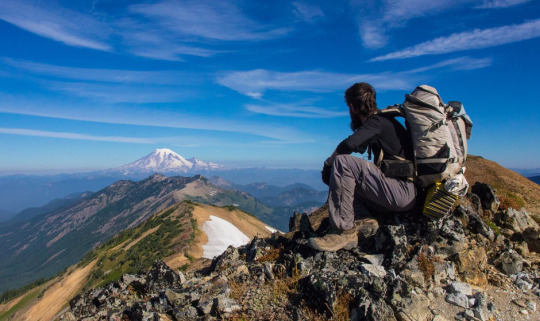
Spanning from the Mexican to the Canadian border, the Pacific Crest Trail offers an immersive journey through the diverse ecosystems of the American West. The trek takes hikers through scorching deserts, glaciated expanses of the Sierra Nevada, and the dense forests of Oregon and Washington. The length and varied terrain of the trek make it one of the toughest but also one of the most rewarding.
Altitude: 4,009 meters (13,153 ft)
Best Time to Go: May to November
Difficulty Level: Very Challenging
4. The Mount Kilimanjaro Trek, Tanzania
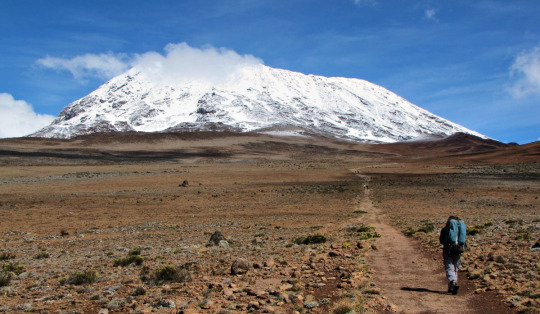
The highest peak in Africa, Mount Kilimanjaro, offers multiple routes for trekkers. Each route presents its unique set of challenges, including altitude sickness, steep inclines, and varying weather conditions. The journey unfolds through five different ecosystems, from lush rainforests and alpine deserts to the icy summit of Uhuru Peak. Despite the challenges, reaching the “Roof of Africa” is an unforgettable experience.
Altitude: 5,895 meters (19,341 ft)
Best Time to Go: January to March and June to October
Difficulty Level: Challenging
5. The Inca Trail to Machu Picchu, Peru
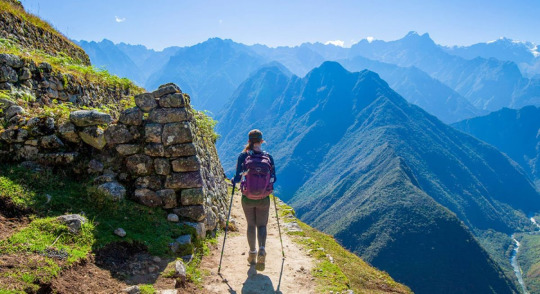
The Inca Trail is a rich journey through a variety of microclimates, across high mountain passes, and into lush subtropical vegetation. This trek provides glimpses into the past, with Incan paving stones, ruins, and tunnels scattered along the route. Despite the physical challenge of the high altitude and the steep ascents and descents, this trek offers an unrivaled reward: the sight of the ancient city of Machu Picchu at sunrise. The combination of natural beauty, fascinating history, and the physical challenge make this one of the most famous treks in the world.
Altitude: 4,200 meters (13,780 ft)
Best Time to Go: May to September
Difficulty Level: Moderate to Challenging
6. Mount Elbrus Trek, Russia
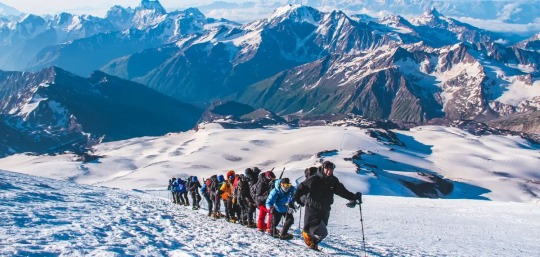
Mount Elbrus, nestled in the heart of the Caucasus Mountains, is the highest peak in Europe. The trek to its summit involves navigating through precarious glaciers and steep inclines. Despite the challenges, it offers panoramic views of the Caucasus and a unique sense of accomplishment. The trek’s difficulty is compounded by the unpredictable weather and the need for proper acclimatization, making it a must for experienced climbers.
Altitude: 5,642 meters (18,510 ft)
Best Time to Go: July to August
Difficulty Level: Very Challenging
7. The Great Himalaya Trail, Nepal
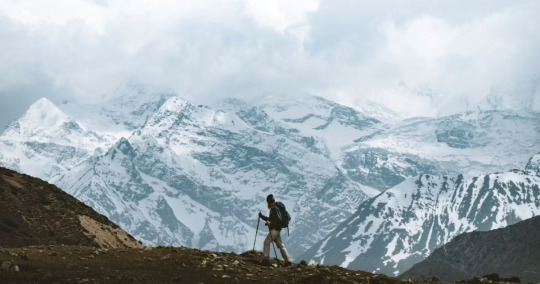
As one of the longest and highest walking trails in the world, the Great Himalaya Trail traverses the full length of the Nepalese Himalayas. This route takes trekkers through some of the wildest and most remote mountain environments on earth. The terrain is challenging and the route is remote, but the breathtaking views of high peaks, passes, and valleys make the trek an unforgettable journey. The trail is a testament to the beauty, diversity, and grandeur of the Himalayan range.
Altitude: 6,146 meters (20,160 ft)
Best Time to Go: March to May and October to November
Difficulty Level: Very Challenging
8. Appalachian Trail, USA
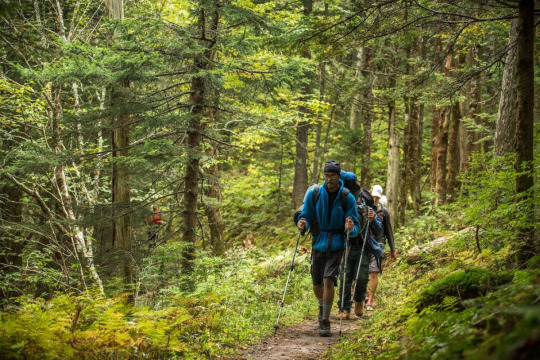
Spanning fourteen U.S. states, the Appalachian Trail is one of the longest continuously marked footpaths in the world. This journey takes hikers through wild landscapes, dense forests, and over numerous mountain peaks. Each section of the trail presents its unique set of challenges, from harsh weather conditions to physically demanding terrain. Still, the trail’s stunning beauty and the sense of accomplishment from completing sections, or the entire trail, draw hikers from around the world.
Altitude: 2,024 meters (6,643 ft)
Best Time to Go: March to September
Difficulty Level: Challenging
9. Overland Track, Australia
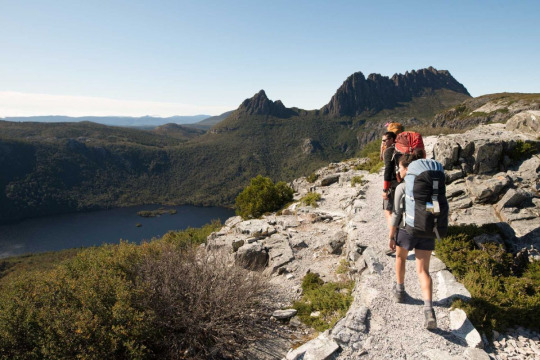
The Overland Track, Australia’s premier alpine walk, takes trekkers through the heart of the Cradle Mountain-Lake St Clair National Park. As part of the Tasmanian Wilderness World Heritage Area, this 65-km trail is a journey of discovery through diverse landscapes. From ancient rainforests and alpine meadows to rugged mountains and sparkling lakes, the track offers breathtaking views at every turn. The challenge of the Overland Track lies in its length and the unpredictable Tasmanian weather, but its stunning scenery and rich biodiversity make it worth the effort.
Altitude: 1,545 meters (5,069 ft)
Best Time to Go: October to May
Difficulty Level: Moderate to Challenging
10. GR20, Corsica
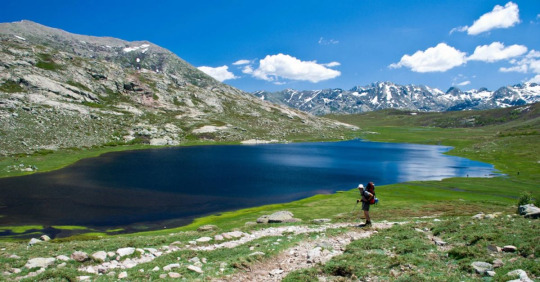
Considered the most challenging long-distance trail in Europe, the GR20 in Corsica stretches from the north to the south across the mountainous heart of the island. This stunning trek takes hikers through rugged peaks, beautiful glacial lakes, and dense forests. The trail’s beauty is matched by its difficulty, with steep ascents, rocky terrain, and often unpredictable weather conditions. The GR20 is a grueling trek but offers a rewarding experience that’s hard to match.
Altitude: 2,706 meters (8,878 ft)
Best Time to Go: June to September
Difficulty Level: Very Challenging
11. The Polar Route, Greenland
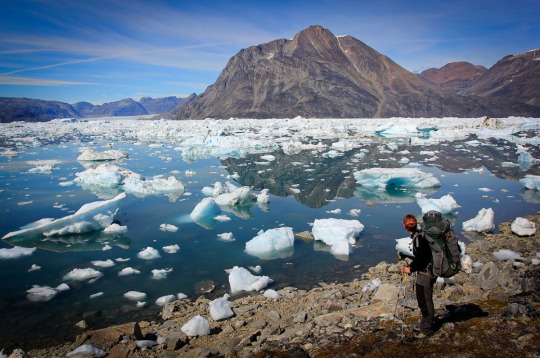
An arctic adventure like no other, the Polar Route in Greenland is a journey through ice fields, fjords, and remote arctic tundra. This challenging expedition tests the endurance of even the most experienced hikers, but the reward is a stunning, untouched wilderness, the chance to witness the Northern Lights, and the possibility of encountering arctic wildlife. The trek’s isolation and the harsh arctic climate add to the difficulty, making it a trek suited for the truly adventurous.
Altitude: Varies, up to 2,000 meters (6,562 ft)
Best Time to Go: April to June
Difficulty Level: Very Challenging
12. Routeburn Track, New Zealand
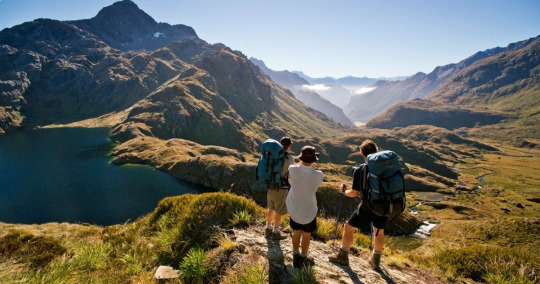
The Routeburn Track, located in New Zealand’s South Island, offers an incredible journey across the Southern Alps. The track winds through vast valleys, pristine alpine lakes, and verdant forests, showcasing the best of New Zealand’s diverse natural beauty. The trail is well-maintained, but the fluctuating weather conditions and the physical demands of the mountainous terrain make it a challenging trek. Regardless, the breathtaking views and the chance to explore the unique landscapes of New Zealand make the Routeburn Track a must-do for any hiking enthusiast.
Altitude: 1,255 meters (4,117 ft)
Best Time to Go: October to April
Difficulty Level: Moderate to Challenging
13. Larapinta Trail, Australia
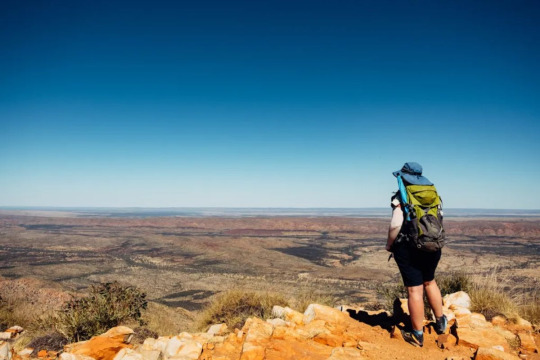
Situated in the heart of Central Australia, the Larapinta Trail extends over 223 kilometers along the spine of the West MacDonnell Ranges. This trail brings you up close to the ancient landscape of the Northern Territory, offering stunning views of jagged ridges, weathered peaks, and the rich, red soil of the Australian Outback. Hikers will encounter a wide variety of wildlife, rare plants, and a stark, captivating beauty that’s unique to this part of the world. The route’s length, combined with the harsh, arid climate, make it a challenging trek.
Altitude: 1,380 meters (4,528 ft)
Best Time to Go: April to September
Difficulty Level: Challenging
14. The Long Range Traverse, Canada
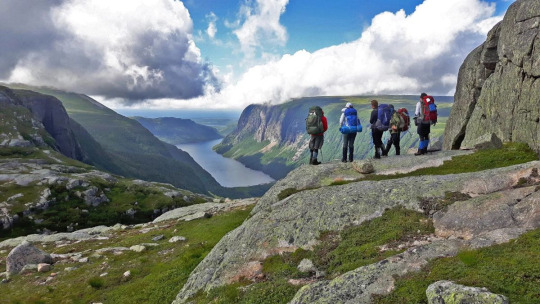
The Long Range Traverse is an unmarked and rugged backcountry route through some of the best wilderness in Canada’s Gros Morne National Park. This challenging trek requires navigation skills as you make your way through dense forest, across bogs, and up steep scree slopes. However, the breathtaking views of fjords, glacial valleys, and the raw, untamed beauty of the Newfoundland wilderness make it worth the effort.
Altitude: 806 meters (2,644 ft)
Best Time to Go: June to September
Difficulty Level: Challenging
15. Dientes Circuit, Chile
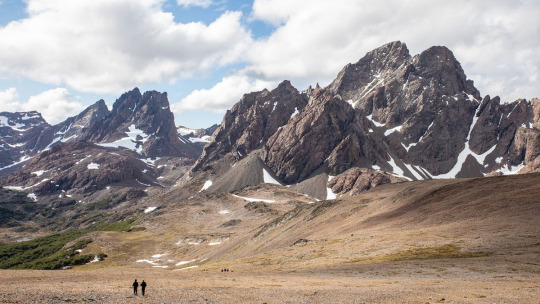
Found on the isolated Isla Navarino in the extreme south of Chile, the Dientes Circuit is a trek like no other. This remote, rugged trail will test your trekking skills as you navigate through untouched Magellanic forests, peat bogs, and steep mountain passes. The views from the trail are unparalleled, with the jagged peaks of the Dientes de Navarino range on one side and the Beagle Channel, Cape Horn, and the snowy mountains of Tierra del Fuego on the other. This trek is not for the faint-hearted, but the stunning, end-of-the-world scenery makes it a must-do for experienced hikers.
Altitude: 800 meters (2,624 ft)
Best Time to Go: December to March
Difficulty Level: Challenging
Conclusion
Tackling these treks isn’t merely about testing your physical stamina. It’s about pushing your boundaries, exploring the unexplored, and discovering your own resilience in the face of adversity. It’s about standing on top of a peak, looking out at the panoramic vistas, and realizing that the world is as vast as it is beautiful – and you’re a part of it.
So, whether you’re a seasoned hiker or an adventurous spirit looking for your next challenge, we hope this list has ignited a spark of wanderlust. Remember, every journey begins with a single step. And who knows? Perhaps your next step will lead you on one of the toughest treks in the world.
After all, as the famous mountaineer, Sir Edmund Hillary once said, “It’s not the mountain we conquer, but ourselves.” So here’s to the treks that await us, the summits yet to be conquered, and the adventures that lie ahead. Happy trekking!
2 notes
·
View notes
Text

Mount Kilimanjaro Trekking | Tanzania: Summit Africa’s Peak Sustainably
Stand atop the “Roof of Africa”, where Mount Kilimanjaro’s iconic glaciers meet cutting-edge eco-trekking innovations. Traverse lush rainforests, alpine deserts, and volcanic ridges en route to Uhuru Peak (5,895m), while Tanzania’s new sustainability protocols protect this UNESCO World Heritage Site. Witness the Glacier—shrinking but still awe-inspiring—and trek upgraded routes with solar-powered campsites, biodegradable gear, and altitude-safety drones for a responsible, life-changing adventure.
BEST TIME TO VISIT
Dry Seasons (Optimal Conditions):
January–March: Quiet trails, lush scenery, and clear skies. Ideal for photographers and solitude seekers.
June–October (Peak Season): High success rates: Strict daily climber quotas—secure permits 6–12 months early
Wet Seasons (Budget-Friendly Adventure): April–May & November–December: Lower crowds, misty landscapes, and rare flora blooms. Prepare for rain and muddy trails
BEST FOR
Adventure Thrill-Seekers | Eco-Conscious Travelers | Bucket-List Climbers | Photography Pros | Stargazing Enthusiasts
ACTIVITIES
✔️ 7–9-Day Summit Climbs on routes like Lemosho (scenic + low traffic) and Machame (challenging + diverse terrain).
✔️ Full-Moon Summit Attempts for surreal glacier views under moonlight
✔️ Chagga Cultural Immersion: Coffee farm tours, waterfall hikes, and Kibo Hut conservation workshops.
✔️ Carbon-Neutral Add-Ons: Plant native trees in Kilimanjaro’s Marangu Reforestation Zone.
✔️ High-Altitude Stargazing: Astronomy tours with GPS-guided constellation mapping.
✔️ Acclimatization Hikes: Explore Shira Plateau or Mawenzi Peak with expert guides.
📍 Location: Mount Kilimanjaro National Park, Tanzania (Gateways: Moshi/Arusha).
#kilimanjaro #trekking #adventure #africa #mountain #hike #travel
0 notes
Text
Climb Kilimanjaro with Experts | Great Image Expedition
Embark on the adventure of a lifetime as you trek through five breathtaking climate zones — from lush rainforest to arctic summit. Choose from 7 iconic routes, including our favorite, the Machame Route, for stunning views and optimal acclimatization.
Whether you prefer the dry season from June to October or the snow-dusted beauty of January to March, Kilimanjaro is climbable year-round.
Led by seasoned guides, our expeditions promise safety, support, and unforgettable summit moments at 5,895m — the roof of Africa.
Now booking 2025 treks + Serengeti safari extensions.
Stay connected in the wild. Start planning today.
Great Image Expedition
https://gie.co.tz/mount-kilimanjaro-trekking/
0 notes
Text
Embark on the Journey of a Lifetime: Discover the Magic of Mount Kilimanjaro Trekking
Standing tall at 5,895 meters, Mount Kilimanjaro is Africa’s highest peak and one of the most iconic trekking destinations in the world. Every year, adventurers from across the globe are drawn to Tanzania to experience the awe and challenge of Mount Kilimanjaro trekking. The trek to the summit, known as Uhuru Peak, is not only a physical journey but also a deeply spiritual and emotional experience for many. Whether you're a seasoned climber or a first-time trekker, Mount Kilimanjaro trekking packages are designed to accommodate various skill levels, offering everyone a chance to witness this breathtaking natural wonder.
What makes trekking Mount Kilimanjaro truly exceptional is the diversity of landscapes you encounter along the way. From lush rainforests at the base to alpine deserts and icy glaciers near the summit, each day of the climb brings a new and captivating environment. The varying ecosystems are home to a wide range of wildlife, exotic plants, and fascinating geological features. Unlike many other high-altitude climbs, Mount Kilimanjaro requires no technical mountaineering skills, which makes it an accessible yet exhilarating goal for many adventure seekers.
There are several routes to choose from when planning your climb, each offering a different experience. The Marangu Route, often called the "Coca-Cola Route," is considered the most straightforward and is the only path with hut accommodations. The Machame Route, known for its scenic beauty, takes a bit longer but provides excellent acclimatization opportunities. Other popular options include the Lemosho, Rongai, and Northern Circuit routes, each offering their own unique perspective of the mountain and surrounding landscape. When exploring Mount Kilimanjaro trekking packages, it's important to consider your fitness level, desired duration, and preferred type of scenery to choose the route that best suits your needs.
Choosing the right tour operator is essential to ensuring a safe, enjoyable, and memorable climb. Companies like Kilislopetoursandsafaris.com specialize in customized trekking experiences, offering a variety of packages that cater to different budgets and preferences. From well-trained guides to quality gear and comfortable campsites, a good operator will handle all logistical aspects of your journey, allowing you to fully immerse yourself in the adventure. Proper planning and preparation are also crucial for success; this includes physical training, understanding altitude sickness, and packing the right clothing and equipment.
Altitude acclimatization is one of the most important factors in reaching the summit successfully. Most Mount Kilimanjaro trekking packages are designed with this in mind, incorporating gradual elevation gains and rest days to allow your body to adjust. Drinking plenty of water, eating nutritious meals, and listening to your guide’s advice are all key strategies for minimizing the effects of altitude sickness and increasing your chances of reaching the summit.
The best time to climb Mount Kilimanjaro is during the dry seasons—January to March and June to October. These months typically offer the most favorable weather conditions, including clear skies and lower chances of rain. However, with the right gear and mindset, it’s possible to trek year-round. The climb can take anywhere from five to nine days, depending on the route and your chosen itinerary.
Trekking Mount Kilimanjaro is not just about reaching the summit; it’s about the journey, the camaraderie, and the personal growth that comes with it. Along the trail, you’ll meet fellow climbers from different backgrounds, each with their own story and motivation for taking on this challenge. The shared experience of pushing boundaries and embracing the raw beauty of nature often leads to lifelong memories and friendships.
For those who dream of standing on the Roof of Africa, Kilislopetoursandsafaris.com offers the expertise and support needed to turn that dream into a reality. With carefully curated Mount Kilimanjaro trekking packages, the path to the summit becomes more than just a climb—it becomes a transformative adventure. Whether you're looking to conquer new heights or simply immerse yourself in the wonders of the natural world, there's no better place to start than the slopes of Kilimanjaro.
0 notes
Text
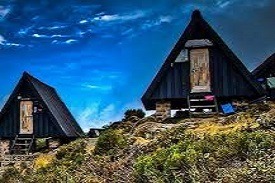
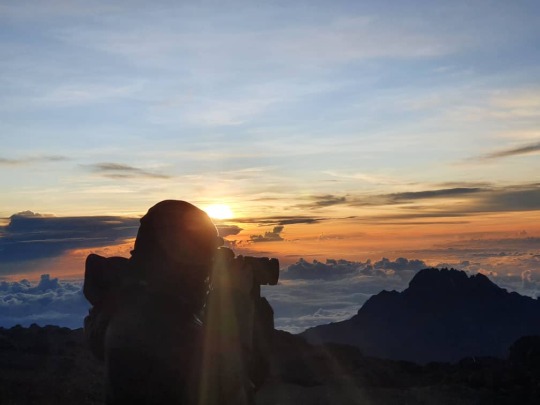
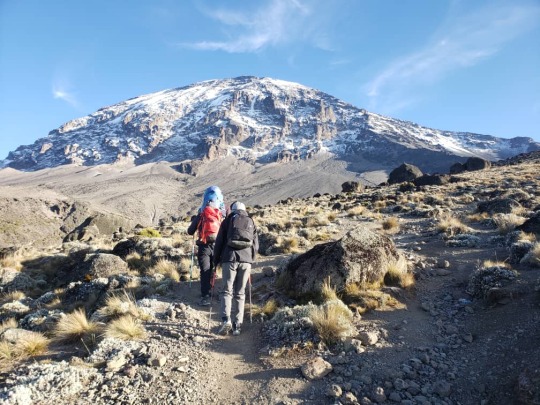
The Marangu route, also known as the "Coca-Cola" route, is the oldest, most well-established route on Kilimanjaro. This is the only route which offers sleeping huts in dormitory style accommodations in lieu of camping. There are 60 bunk beds each at Mandara and Kibo Huts, and 120 bunk beds at Horombo Hut. Guests are supplied with mattresses and pillows, but sleeping bags are still required. The huts have communal dining halls and basic washrooms, ranging from flushing toilets and running water at the lower huts to long drop toilets and buckets of water at Kibo Hut. Many favor Marangu because it is considered to be the easiest path on the mountain, given its gradual slope and direct path. However, the short time frame of the route makes Altitude Acclimatization fairly difficult. The route approaches Mount Kilimanjaro from the southeast. Marangu is unfortunately less scenic than the other routes because the ascent and descent are along the same path. It is also the most crowded route for that reason.
Day 1: Marangu Gate to Mandara Hut Elevation (ft): 6,046 ft to 8,858 ft Distance: 8 km Hiking Time: 4-5 hours Habitat: Rain Forest Hut: Mandara Hut. We head to the Marangu Gate for the necessary formalities before beginning our trek. The trail climbs through a tropical rain forest near the upper edge of the forest line, where we sometimes see playful blue monkeys. The trail then widens to expose beautiful hillsides until we reach Mandara Hut.
Day 2: Mandara Hut to Horombo Hut Elevation (ft): 8,858 ft to 12,205 ft Distance: 12 km Hiking Time: 6-8 hours Habitat: Heath / Moorland Our second day on the trail starts up with a steep ascent through the forest and opens into high moorland. If the sky is clear, we might get our first views of Kibo and Mawenzi Peaks. Those two volcanic peaks make up the summit of Kilimanjaro.
Day 3: Horombo Hut to Mawenzi Hut to Horombo Hut Elevation (ft): 12,205 ft to 14,160 ft to 12,205 ft Distance: 10 km Hiking Time: 3-5 hours Habitat: Heath This extra day is used for Adaptation. We hike towards or all the way to Mawenzi Hut and back. The unique landscape offers motivating views of Kibo and Mawenzi.
Day 4: Horombo Hut to Kibo Hut Elevation (ft): 12,205 ft to 15,430 ft Distance: 10 km Hiking Time: 6-8 hours Habitat: Alpine Desert On this day we climb gently, then cross the lunar desert of the “Saddle” between Mawenzi and Kibo to reach our campsite, which sits at the bottom of the Kibo crater wall. Once at Camp, we rest and enjoying an early dinner and prepare for summit day.
Day 5: Kibo Hut to Uhuru Point to Horombo Hut Elevation (ft): 15,430 ft to 19,341 ft to 12,205 ft Distance: 22 km Hiking Time: 10-13 hours Habitat: Arctic We wake up in the middle of the night and begin the final push to reach the Roof of Africa. The trail to Gilman’s Point is very steep, and the ascent will be slow and steady. From Gilman’s, it is a traverse along the crater rim to Uhuru Peak. We stay at the summit for a short time, to take photos and enjoy the views, before retracing our steps all the way back to Horombo Hut.
Day 6: Horombo Hut to Marangu Gate Elevation (ft): 12,205 ft to 6,046 ft Distance: 20 km Hiking Time: 5-7 hours Habitat: Rain Forest A long trek is in store for today, however it is mostly downhill. Once we reach the park headquarters, there at Marangu Gate, we pick up our certificate, that proves our achievement, and catch our vehicle transfer to the Hotel in Moshi.
Included o Park fees, o Hut fees o Rescue fees o 18% VAT on tour fees & services, which cost nearly 55 % of the total cost charged. o Transportation to & from the Mountain Gate o Professional mountain guides, cooks and porters o 3 meals daily while on the mountain
Not Included o Both national and international flights o Medical Insurance o Tips to Mountain Crew o Items of a personal nature o Laundry Services o Alcoholic beverages
Contact Us via WhatApp +255 786499087
Email us Direct: [email protected]
#Marangu Route 6 days Trek#Kilimanjaro Marangu Itinerary#Marangu Route Summit Climb#6-day Marangu Route Highlights#Kilimanjaro Marangu Huts#Marangu Route Acclimatization#Best Time to Hike Marangu#Marangu Route Camping Options#Kilimanjaro Scenic Views#Marangu Route Difficulty Level#Kilimanjaro National Park#Marangu Route Accommodation#Kilimanjaro Guided Expeditions#Marangu Route Altitude Sickness#Kilimanjaro Weather Conditions#Marangu Route Trekking Adventure#Kilimanjaro Uhuru Peak Ascent#Marangu Route Flora and Fauna#Kilimanjaro Cultural Tours
0 notes
Text
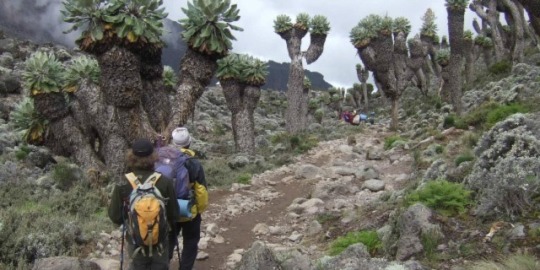
Both the Lemosho and Machame routes offer unique and rewarding experiences for climbers seeking to conquer Mount Kilimanjaro. The Lemosho route stands out for its scenic beauty, tranquility, and higher success rates due to its longer duration and gradual ascent. It provides ample time for acclimatization, increasing the chances of reaching the summit.
On the other hand, the Machame route is known for its popularity, diverse landscapes, and challenging sections that add an element of adventure to the climb. It offers a more direct and steeper ascent, making it suitable for experienced hikers who are comfortable with more rugged terrain.
Ultimately, the choice between the Lemosho and Machame routes depends on your preferences, fitness level, and hiking experience. Both routes provide incredible views, encounters with unique flora and fauna, and a sense of achievement upon reaching the summit. Whichever route you choose, proper preparation, physical fitness, and acclimatization are essential for a safe and successful Kilimanjaro adventure.
No matter which route you embark on, Climbing Mount Kilimanjaro is an awe-inspiring and life-changing journey. So, lace up your boots, prepare yourself mentally and physically, and embark on an adventure of a lifetime to conquer Africa's highest peak.
For more information visit this blog @
#kilimanjaro routes#kilimanjaro mountain#mt kilimanjaro#kilimanjaro#mount kilimanjaro#tarangirenationalpark#tanzania safaris#safaris in tanzania#tanzania safari tours#safari in tanzania
5 notes
·
View notes
Text
Experience Mount Meru Trekking's Thrills.
Adventurers will discover mount meru trekking to be a top-notch revel in. Rising at 4,566 meters, Mount Meru is the second-highest mountain in Tanzania, proper inside the center of the state. For everybody who enjoys nature and adventure, its rugged splendor, exquisite range, and high-quality scenery make it a need-to-do experience. Offering breathtaking views of the encircling region, the stroll winds over rocky terrain, wealthy rainforests, and excessive-altitude alpine deserts. Ascending will let you see animals consisting of buffaloes, monkeys, and different hen species. The peak offers incredible sweeping vistas, including a magnificent perspective of Mount Kilimanjaro.
Why Select a Package for a Kilimanjaro Climb?
A Kilimanjaro climb bundle might be the perfect approach to guarantee a deliberate and successful upgrade while considering a trekking experience in Tanzania. Rising as the tallest height in Africa, Kilimanjaro draws hikers from all over the world. Often seen as a once-in-a-lifetime adventure, the climb offers professional advice, professional offerings, and logistical help together with a package. Usually, packages comprise the whole thing from food and tour to lodging and shipping, in addition to professional courses. For first-timers mainly, this helps to smooth out the experience and increase safety. A well-organized Kilimanjaro climb package improves the experience, whether your goals are to reach the summit or enjoy the trip.
The Terrestrial Unique Beauty of Mount Meru
The different landscape presented by Mount Meru hiking highlights the range of ecosystems found in Tanzania. Trekkers beginning at the foot of the mountain will go via tropical woods bursting with rich vegetation and the sounds of life. The scene changes as you ascend; alpine meadows give way to desolate volcanic rock. Mount Meru is unusual in terms of vegetation, as its many ecosystems sustain various kinds of plants and animals. For photographers and wildlife enthusiasts, this slow shift in landscape captures a picture of the many ecosystems Tanzania is known for, thereby making the walk enjoyable.
Safety and Professional Guideline for Your Mount Meru Trekking Adventure
Starting a Mount Meru hiking experience gives safety first concern. Especially when you climb, the road might be difficult; hence, it is essential to have a professional guide. By providing insightful knowledge on the geology, animals, and history of the mountain, guides not only guarantee safety but also improve your experience. From altitude sickness avoidance to negotiating the rugged terrain, they are taught to handle the many obstacles of the trip. Having professionals by your side lets you concentrate on savoring the journey and feel sure of your safety, therefore transforming the excursion into both a fun and safe one.
Preparation and Acclimatization for the Package Kilimanjaro Climb
When climbing Kilimanjaro, practice is crucial; a package usually consists of acclimatization software to ensure the trekkers adapt to the higher elevations. Preventing altitude illness—which might also strike climbers at tremendous heights—is dependent on acclimatization. Many climb tours provide a multi-day timetable that allows us hikers to ascend gently so the frame can regulate the thin air. This careful approach will increase your chances of achieving the top and facilitate the ascent to be more satisfactory. Appropriate making plans and acclimatization will let you enjoy the climb to the top of Mount Kilimanjaro with extra protection and ease.
Conclusion:
Mount Meru hiking or a Kilimanjaro climb package provides top-notch possibilities for excitement and magnificent vistas regardless of your desire. Experienced guides, thorough itineraries, and well-thought-out logistics help you thoroughly and pleasantly explore Tanzania's splendid highlands. Your lifelong stories from the Mount Meru or Kilimanjaro trek could be priceless. Booking with a reputable tour operator will help you to have a fantastic trekking trip. Visit Viva Africa Tours to discover more about these tremendous adventure packages, and start to organize your next great trip right now!
0 notes
Text
Cost of Climbing Mt Kilimanjaro – Cost Varies According to Number of Days

The cost of climbing Mt Kilimanjaro depends on varied factors. Tour packages are provided for different numbers of days. Choosing the best one will be a crucial decision to make. Reaching a recognized travel planner will be the first crucial step to start climbing and enjoy your days. If you are one of them looking for the dynamic ways to enjoy the duo of adventure and natural beauty, choosing the right package will be an ideal way.
Simba Adventures is one of the trusted and recognized tour planners offering you attractive packages at affordable cost of climbing Mt Kilimanjaro. Their packages activities have been featuring three peaks in which they specialize in and most visited by travelers who are visiting Tanzania. You will get packages for Mount Kilimanjaro (5895 meter), Mount Meru (4556 meter), and Mount OI Donyo Lengai (2962 meters)
Our Tanzania climbing and trekking packages activities featuring three peaks in which we specialize in and most visited by many travelers visiting Tanzania include Mount Kilimanjaro 5895m, Mount Meru 4566m and Mount Ol Donyo Lengai 2962m (Ngorongoro highlands). These are the most frequent expeditions in Tanzania.
Every mountain is unique from each other. You have to decide to climb on the selected one or more. Simba Adventures will be more than happy to put together an itinerary that suits your preferences. It is advisable, especially when climbing at higher altitudes, to take things slowly and allow your body to acclimatize. Mountaineering is sport, hobby or profession of walking, hiking, backpacking and climbing. You will get attractive plans and packages that are designed specifically to provide you with an entirely different experience. Pre-booking of the tour package will be an ideal way to help you enjoy the best time.
0 notes
Text
Mount Kilimanjaro Trek: A Journey to the Roof of Africa 🏔️
Mount Kilimanjaro, the highest peak in Africa, stands as a majestic symbol of adventure and natural beauty. For those with a passion for trekking and a desire to challenge themselves, the Mount Kilimanjaro trek offers an experience like no other. From lush rainforests to icy glaciers, this iconic mountain offers a diverse and thrilling adventure that’s on the bucket list of many.
In this blog, we'll guide you through everything you need to know about trekking Mount Kilimanjaro, including preparation tips, routes, and what to expect on this unforgettable journey. 🌍

Why Trek Mount Kilimanjaro? 🏞️
The allure of Mount Kilimanjaro is undeniable. Here are some reasons why it should be on your bucket list:
The Height: Standing at 5,895 meters (19,341 feet), Kilimanjaro is the tallest mountain in Africa. Reaching the summit, Uhuru Peak, is a significant achievement for many.
The Diverse Landscapes: From tropical rainforests to alpine deserts and glaciers, the trek offers a variety of ecosystems, each more breathtaking than the last.
A Challenge for All: Unlike other high-altitude mountains, Kilimanjaro doesn’t require technical climbing skills, making it accessible to trekkers with varying levels of experience.
Best Time to Trek Mount Kilimanjaro 🌞❄️
The best time to embark on a Kilimanjaro trek is during the dry seasons:
January to March: The weather is generally dry and sunny, making it the perfect time for a trek.
June to October: This is the peak season, offering clear skies and optimal trekking conditions.
Avoid the Rainy Seasons: The long rains (April to May) and short rains (November to December) bring unpredictable weather and slippery trails.
What to Expect During Your Trek ⛰️
Day 1: Starting the Adventure 🌄
The adventure begins as you trek through the lush rainforests. Expect to see monkeys, colorful birds, and a variety of plant life as you start your journey.
Day 2-4: Moving Through Different Ecosystems 🍃
As you ascend, the terrain gradually changes. You'll pass through the moorland, alpine desert, and eventually the glacier zone. The higher you go, the more challenging the conditions become. Be prepared for colder temperatures and a thinner atmosphere!
Summit Day: Reaching Uhuru Peak 🎉
The summit day is the toughest part of the trek. You’ll start your climb in the dark to reach Uhuru Peak in the early hours of the morning to catch the sunrise. The views from the top are absolutely spectacular, and the sense of accomplishment is unparalleled.
Day 6: Descending Back to Base 🏁
After summiting, the descent is much faster. You'll retrace your steps back to the base, reflecting on the incredible journey you’ve just completed.
Preparing for the Kilimanjaro Trek 🏋️♂️
A successful trek requires preparation. Here are some tips to help you get ready for this adventure:
1. Physical Fitness 🏃♀️
While Kilimanjaro doesn’t require technical climbing skills, it does demand stamina and endurance. Regular cardiovascular exercises like hiking, running, or cycling will prepare your body for the trek.
2. Mental Preparation 🧠
The mental challenge is as significant as the physical one. Be ready for long days, altitude sickness, and unpredictable weather. Keeping a positive attitude and staying determined will help you succeed.
3. Proper Gear 🎒
Investing in the right gear is essential for your comfort and safety. Make sure you have:
Layered clothing for varying temperatures
Waterproof boots and gloves
A headlamp for summit night
A good sleeping bag for the cold nights
4. Acclimatization 🌬️
Altitude sickness is a real risk when trekking at high altitudes. It’s vital to take your time, stay hydrated, and allow your body to adjust to the thinner air.
What to Pack for Your Kilimanjaro Trek 🎒
Here’s a checklist of essentials to bring along:
Clothing: Moisture-wicking base layers, insulated jacket, gloves, and hat.
Footwear: High-quality hiking boots, gaiters, and warm socks.
Food and Water: Snacks for energy and a hydration system.
Medical Kit: Include any personal medications, altitude sickness remedies, and basic first aid items.

The Cost of Trekking Mount Kilimanjaro 💰
Trekking Mount Kilimanjaro is an investment, and costs can range from $1,500 to $5,000 depending on the route, the number of days, and the level of service (luxury or basic). It’s important to choose a reputable guide service to ensure a safe and enjoyable experience.
Conclusion:
A Mount Kilimanjaro trek is more than just a physical challenge – it's a journey of self-discovery. Reaching the summit and witnessing the sunrise over the African savannah is a once-in-a-lifetime experience that will stay with you forever.
So, are you ready to conquer the Roof of Africa? The adventure of a lifetime awaits! 🏅
1 note
·
View note
Text
Why should you choose the amazing luxury africa safari tours?
Africa provides an exhilarating spectrum of travel opportunities, ranging from the demanding climb up Mount Kilimanjaro to the epitome of luxury on a luxury African safari. Whether you are looking for a demanding climb to the top of Africa's highest peak or a luxury safari adventure in the continent's finest wildlife sanctuaries, these safaris provide memories that last a lifetime. Are you someone who wants to gather more facts about the mount kilimanjaro climbing tours, luxury africa safari tours? If Yes. This is the best place where people can gather more facts about the mount kilimanjaro climbing tours, luxury africa safari tours. Mount Kilimanjaro Climbing Tours
Africa provides an exhilarating spectrum of travel opportunities, ranging from the demanding climb up Mount Kilimanjaro to the epitome of luxury on a luxury African safari. Whether you are looking for a demanding climb to the top of Africa's highest peak or a luxury safari adventure in the continent's finest wildlife sanctuaries, these safaris provide memories that last a lifetime. Are you someone who wants to gather more facts about the mount kilimanjaro climbing tours, luxury africa safari tours? If Yes. This is the best place where people can gather more facts about the mount kilimanjaro climbing tours, luxury africa safari tours.
Mount Kilimanjaro Climbing Tours
Technical climbing ability is not required to overcome Kilimanjaro for this peak, but something considered for hard-core climbers and beginners alike. It is just a matter of preparation, stamina, and where one climbs.
There are a number of trails to the mountain, each with its own difficulties and scenery. The Machame Route, provides decent scenery and high success rates as a result of acclimatization. The Marangu Route, is the sole route to use hut facilities, so it's a physically less demanding climb. Climbers traverse varied landscapes, from dense rainforest to alpine deserts, before finally arriving at the ice-capped Uhuru Peak summit.

A guided climb of Kilimanjaro provides safety, professional guidance, and support arrangements, including porters, cooks, and accommodation. The feeling of achievement standing atop the mountain, combined with the breathtaking panoramic scenery, makes this climb an experience that can transform your life.
For the tourist looking for close, personal wildlife experience, a Luxury Africa Safari Tours offers the ideal mix of comfort, adventure, and personalized service. In contrast with other safaris, luxury safaris provide private viewing of game, top lodges, gourmet food, and friendly luxuries.
Luxury safaris are planned with luxury and privacy in mind and include spacious tented camps, boutique lodges, and exclusive conservancies. Customized itineraries are crafted to fit personal tastes, whether a romantic honeymoon safari, a family safari, or a photographic safari.
Both top-class African safaris and Mount Kilimanjaro climbing tours are once-in-a-lifetime experiences. Whether ascending the highest peak on the continent or taking an award-winning safari, each tour guarantees thrills, glory, and memories to last forever.
#luxury africa safari tours#mount kilimanjaro climbing tours#Serengeti National Park tour package#masai mara and serengeti safari tours
0 notes
Text
Challenging 7-Day Londorossi Route Trek on Kilimanjaro
Take on the challenging 7 days Mount Kilimanjaro climbing Londorossi route with Aardvark Expeditions and immerse yourself in a less-traveled path to the summit. This route offers both breathtaking scenery and a higher chance of acclimatization, passing through lush rainforests and rugged landscapes before reaching the awe-inspiring summit of Africa’s tallest peak.
visit:https://www.aardvark-expeditions.com/6-days-mount-kilimanjaro-climbing-marangu-route/
0 notes